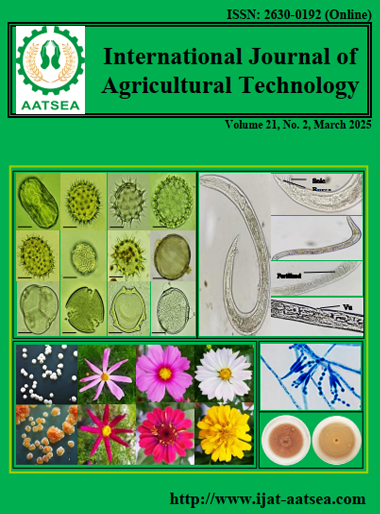Species of commercially-farmed crickets in Thailand
Main Article Content
Abstract
Result found that there are four species of commercially farmed crickets in Thailand with some farms raising two or more types of crickets. First, the “Thongdum Cricket” (Two-spotted cricket, Gryllus bimaculatus) is the most commonly raised in 92 farms. The “Thongdum Cricket” has two phenotypes as the red-coloured and black-coloured body. Genetic evidence from mitochondrial DNA sequences at the cytochrome oxidase I (COI) gene found that these two phenotypes are found in the same species. Second, the “House Cricket” (Acheta domesticus) commonly known in Thai as “Sa-ding” is raised in 65 farms. Third, the “Thongdaeng Cricket” (Ground Cricket, Teleogryllus mitratus) has yellow V-shape mark between the two eyes when viewed anteriorly and is raised in 33 farms. The name “Jing Krong” is often mistaken which instead of the correct one of “Thongdaeng Cricket”. The genetic sequence information confirmed these species should be named “Thongdaeng Cricket”. Last, “Thonglai Cricket” (Crazy red field cricket, Gryllus locorojo) has distinct M-shaped marking on the head, and the body is red-brown. This species is raised in 15 farms, and is often mistakenly called “Vietnam Cricket” because they were imported originally from Vietnam.
Article Details

This work is licensed under a Creative Commons Attribution-NonCommercial-NoDerivatives 4.0 International License.
References
Hanboonsong, Y., Jamjanya, T. and Durst, P. B. (2013). Six-legged livestock: edible insect farming, collection and marketing in Thailand. RAP publication, Bangkok, Thailand. p. 57.
Hanboonsong, Y., Jamjanya, T., Tubtim, N. and Itthichan, L. (2018). Handbook for farming standard of insects for human and animal consumption. Bangkok: Biodiversity-based Economy Development Office (BEDO). p.44.
Kusuma na Ayuthya, T. (2022). Farmers in Khon Kean raise Jing Grong which was not enough for customers. Retrieved from https://www.technologychaoban.com/bullet-news-today/article_101066
Lu, H., Wang, X. Y., Wang, H. Q., Li, K. and He, Z. Q. (2018). A taxonomic study of genus Teleogryllus from East Asia (Insecta: Orthoptera: Gryllidae). Journal of Asia-Pacific Entomology, 21:667-675.
Meticulous ResearchTM Analysis. (2018). Edible Insects Market by Product Type (Whole Insect, Insect Powder, Insect Meal, Insect Type (Crickets, Black Soldier Fly, Mealworms), Application (Animal Feed, Protein Bar and Shakes, Bakery, Confectionery, Beverages) - Global Forecast to 2030. Retrieved from https://www.meticulousresearch.com/product/edible-insects-market-forecast
Otte, D. and Cade, W. (1984). African crickets (Gryllidae). 6. The genus Gryllus and some related genera (Gryllinae, Gryllini). Proceedings of the Academy of Natural Sciences of Philadelphia, 136:98-122.
Singh, Y. (2017). Cricket Nutrition Facts | Cricket vs. Beef. Retrieved from http://www.aketta.com/blog/ cricket-nutrition-facts-cricket-vs-beef.aspx
Thansettakij. (2016). Department of Agriculture pushes crickets to become economically important insect. Retrieved from http://www.thansettakij.com/content/109871
Weissman, D. B., Gray, D. A., Pham, H. T. and Tijssen, P. (2012). Billions and billions sold: pet-feeder crickets (Orthoptera: Gryllidae), commercial cricket farms, an epizootic densovirus, and government regulations make for a potential disaster. Zootaxa, 3504:67-88.
Weissman, D. B., Walker, T. J. and Gray, D. A. (2009). The field cricket Gryllus assimilis and two new sister species (Orthoptera: Gryllidae). Annals of the Entomological Society of America, 102:367-380.


